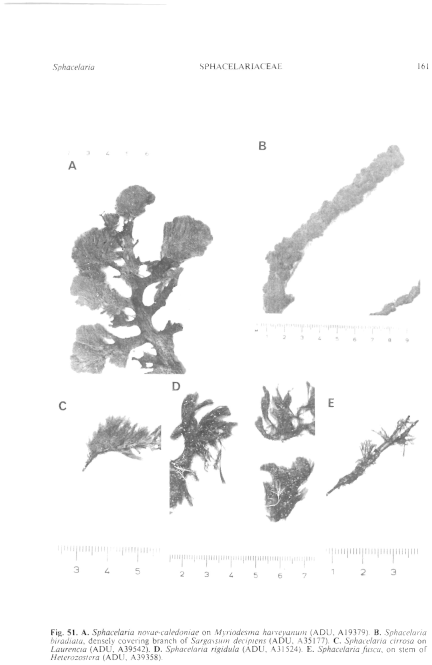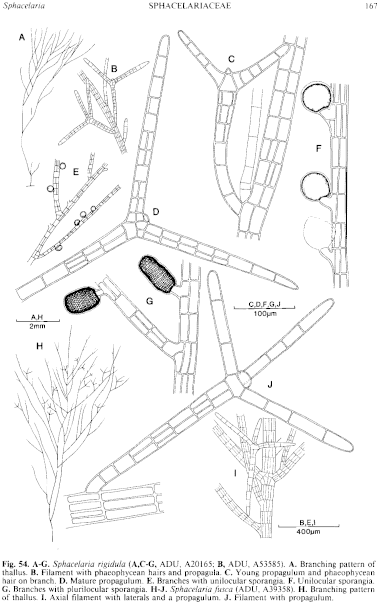|
|
|
|
|
|||||||||||
|
Electronic Flora of South Australia Species Fact Sheet
Phylum Phaeophyta – Order Sphacelariales – Family Sphacelariaceae
Selected citations: Harvey 1848: pl. 149. Prud'homme van Reine 1982: 220, figs 555–564. Sauvageau 1902: 399 (R211), fig. 43. Womersley 1967: 199.
Thallus (Figs 51 E, 54H) medium to dark brown, 0.5–2 (–3) cm long, forming loose to fairly dense tufts, usually epiphytic, sometimes epilithic, rising from small basal discs. Branching (Fig. 54H,1) of well developed axes frequent, irregularly radial, with laterals either indeterminate or somewhat determinate, alternate or opposite, arising at narrow to broad angles and reaching varying heights; phaeophycean hairs usually frequent, 15–25 µm in diameter. Axe: (Fig. 541,.1) (45–) 60–80 (–90) µm in diameter with segments L/B (0.7–) 0.8–1.2 (–1.5) and showing 3–5 longitudinal walls; laterals (Fig. 541) (25–) 40–65 ,um in diameter with segments L/B 1.0–1.5 and showing 1–3 longitudinal walls, decreasing only slightly to apical cells; secondary transverse walls absent to rare.
Reproduction: Propagula (Fig. 541,J) mostly with three, occasionally 2 or 4. slender. cylindrical arms each 200–400 µm long and 20–30 (–35) µm in diameter, borne on a pedicel 240–500 gm long, and with a small, lenticular apical cell which does not develop further.
Plurilocular and unilocular zooidangia unknown.
Type from Sidmouth, England (Griffiths): neotype in TCD.
Distribution: Widespread in temperate seas.
In southern Australia, known from the following localities from W. Aust. to Westernport Bay, Vic.
Taxonomic notes: As Prud'homme van Reine (1982) found for Europe, S. fusca is far less common than the closely related S. rigidula, and in southern Australia most collections have been on axes of Caulocystis. S. fusca differs from S. rigidula in having more distinct axes with laterals spreading at wider angles, and the lower axes are distinctly broader than upper laterals or compared to S. rigidula. The propagula more typically have 3 arms compared to the more usual two in the latter species.
References:
GOODBAND, S.J. (1971). The taxonomy of Sphacelaria cirrosa (Roth) Ag., Sphacelaria fusca (Huds.) Ag., and Sphacelaria furcigera (Kuetz.) Sauv. A simple statistical approach. Ann. Bot. 35, 957–980.
HARVEY, W.H. (1848). Phycologia Britannica. Plates 145–216. (Reeve: London.)
PRUD'HOMME VAN REINE, W.F. (1982). A taxonomic revision of the European Sphacelariaceae (Sphacelariales, Phaeophyceae). Leiden Botanical Series, Vol. 6. (Brill: Leiden.)
WOMERSLEY, H.B.S. (1967). A critical survey of the marine algae of southern Australia. II. Phaeophyta. Aust. J. Bot. 15, 189–270.
The Marine Benthic Flora of Southern Australia Part II complete list of references.
Publication:
Womersley, H.B.S. (14 December, 1987)
The Marine Benthic Flora of Southern Australia
Part II
©Board of the Botanic Gardens and State Herbarium, Government of South Australia
Illustrations in Womersley Part II, 1997: FIGS 51E, 54 H–J.

Figure 51 enlarge
Fig. 51. A. Sphacelaria novae-caledoniae on Myriodesma harveyanum (ADU, A19379). B. Sphacelaria biradiata, densely covering branch of Sargassum decipiens (ADU, A35177). C. Sphacelaria cirrosa on Laurencea (ADU, A39542). D. Sphacelaria rigidula (ADU, A31524). E. Sphacelaria fusca, on stem of lieterozostera (ADU, A39358).

Figure 54 enlarge
Fig. 54. A–G. Sphacelaria rigidula ( A,C–G, ADU, A20165; B, ADU, A53585). A. Branching pattern of thallus. B. Filament with phaeophycean hairs and propagula. C. Young propagulum and phaeophycean hair on branch. D. Mature propagulum. E. Branches with unilocular sporangia. F. Unilocular sporangia. G. Branches with plurilocular sporangia. H–J. Sphacelaria fusca (ADU, A39358). H. Branching pattern of thallus. I. Axial filament with laterals and a propagulum. J. Filament with propagulum.

|
Email Contact: State Herbarium of South Australia |

|